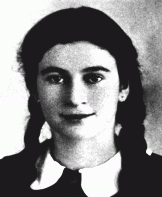
Gerda Weissmann
Born: May 8, 1924
Bielsko, Poland
Gerda was born to a Jewish middle-class family in Bielsko, Poland, a town noted for its textile industry. She began her education in Polish public school, but later entered a Catholic girls school. A rabbi was permitted to come into the school and instruct the Jewish students in religious studies.
1933-39: On Friday, September 1, 1939, German fighter planes appeared overhead, causing many people to flee the city. Gerda's family remained and lived through the intense shelling that followed on Sunday evening. In the morning they heard a tremendous roar. Two German soldiers raced up the street on a motorcycle. They heard people shouting "Heil Hitler" and a black, white and red swastika flag suddenly fluttered from a window across the street.
1940-45: After being moved to Bielsko's ghetto, Gerda was deported in 1942 to work in a textile mill in Bolkenhain, Silesia. Despite the hunger and backbreaking labor, there was caring among the inmates. A German supervisor, Mrs. Kugler, even saved Gerda's life. Gerda had fallen ill and went to the camp hospital. Mrs. Kugler knew that an SS man was inspecting and that the sick would be gassed. She dragged Gerda back to the factory, started her loom and set her in front of it. Gerda was delirious from fever, but she passed the inspection.
Gerda was later sent to slave-labor camps in Marzdorf, Landshut, and Gruenberg. She was liberated by the American army in May 1945, and immigrated to the United States in 1946.